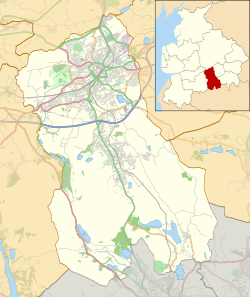In the first half of the 13th century Tockholes was found to be held in thegnage by a local family of the name of Pleasington for a yearly service of 2s. [5] The manor was split in half between Robert de Pleasington and Elias de Pleasington. The manor was subsequently held in demesne by a Joice de Tockholes and a Geoffrey de Sutton. In around 1250 Joice de Tockholes released his tenement to His Lord Elias de Pleasington and at some point during the early reign of Edward I, A William de Livesey was mesne tenant here and was granted the feudal rights and services due from Geoffrey de Sutton. [6]
In 1314–15 the son of John de Pleasington, Robert conveyed his land to William de Holand and in 1332 he granted the manor of Tockholes in fee to Robert de Radcliffe.
Civil War
In 1833 a large pit was discovered in Tockholes located in a field with the official title of "Pit Field", this field had previously been known locally as "Kill Field". In the pit were found the remains of some forty horses along with Cannonballs, Clubs and Large Buttons.
At some point during the Civil War, either during the course of the Earl of Derby's movements between Preston, Bolton, and Blackburn in 1643, or in 1644 with the passage of Prince Rupert's army, severe fighting took place about the lower part of Tockholes, in the vicinity of the church and then on to Cartridge-hill and Hollinshead Hall. Several cannonballs have been picked up in other parts of Tockholes, One was found in a field just above the Bethesda Chapel and another was found on Cartridge-hill, a lofty fell a mile or so further to the south above Hollinshead Hall. Musket bullets have also been found in a field behind the Old Independent Chapel only a short distance from the "Kill Field" Pit. The artifacts recovered in Tockholes seem to indicate a severe battle in which troops, horses and musketeers were engaged and in which at least one piece of ordnance was brought into use by one side or the other. A battle in which at least forty horses were killed must have been quite a fierce one for such a small village.
As the pit was found so close to the old Church of Tockholes, it is supposed that the bodies of the soldiers killed in the Battle would have been removed and buried in consecrated ground, their weapons and items of value being claimed by the prevailing side. [7]



